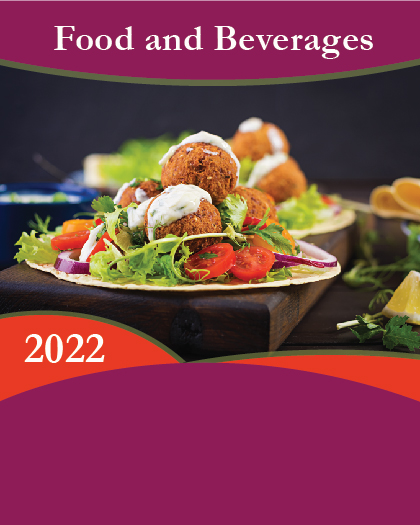

Emulsion can be described as an emulsion process that consists of at least one immiscible liquid dispersed in another liquid in the form of droplets, whose diameter exceeds 0.1 ?m. Earlier emulsions were used in pharmaceutical and animal nutrition industries; however, their use in the food industry has grown noticeably in the past decade. Emulsion in the food is processed to make changes in its organoleptic and physicochemical characteristics such as texture, appearance, taste, flavor, and shelf life. A few major types of emulsion techniques used in the production of emulsifiers or to activate the emulsion process in foods include macroemulsion, nanoemulsion and multiple emulsion. Nanoemulsions are known as particles having structures of 20-200 nm droplet diameter. They are superior to conventional emulsions, owing to the fact that they have a transparent, semi-translucent appearance; comparatively smaller droplet size; and most are stable against sedimentation & creaming. In addition, they tend to increase bioavailability. Moreover, as nanoemulsions provide a wide surface area, they cause the active components in the food to be penetrated rapidly. Unlike thermodynamically stable microemulsions, nanoemulsions are unstable systems, which might be exposed to environmental degradation. Thus, high-energy methods are required to process nanoemulsions. Three types of nanoemulsions includes small-molecule surfactant, protein-stabilized emulsions, and polysaccharide. Depending upon the size and type, nanoemulsions can be used in various industries such as cosmetics, food & beverage, and pharmaceutical industries. Small-molecule surfactants lie between the size of 0-100 nm. Polysorbate 80 and Polysorbate 20 are the most commonly used surfactants in food industry. The size range of protein-stabilized emulsions is between 100 nm and 400 nm. Whey protein isolates, lactoferrin, and sodium caseinate are the most commonly used emulsions. The size of polysaccharides lies between 400 nm and 1,000 nm. Most commonly used polysaccharides are gum arabic, pectin, and octenyl succinic anhydride starch. Nanoemulsions are majorly used in food applications to encapsulate various aromas, certain bioactive compounds, or sensitive food compounds, and to produce low-fat products. Moreover, they are able to encapsulate a diverse range of lipophilic compounds, including bioactive lipids, flavors, antimicrobials, antioxidants, and drugs, thus increasing their bioactivity, desirability, and palatability. Furthermore, they find their application in bakery, dairy, and beverages industries. Increase in popularity of nanoemulsions in the food industry, due to their stability, optical transparency, and diffusion characteristics fuels the market growth. They are widely used for flavor encapsulation, food preservation, food safety, and to maintain food quality, which further boosts their need in the food industry. The process of nanoemulsifying a food item takes incurs high cost. Hence, lowering the cost of the technique will be accepted widely by the local manufacturers. Nanoemulsions have potential advantages over conventional emulsions such as their improved bioavailability and physical stability. However, there are a number of regulatory aspects that should be overcome to for wide applicability of nanoemulsions. From availability of conventional emulsifiers in the market for long period to high cost of processing nanoemulsifiers being high, the factor of cost poses a potential threat to the market in developing as well as underdeveloped countries. The global nanoemulsion market is segmented into type, application, and region. Depending on type, the market is classified into small-molecule surfactant, protein-stabilized emulsion, and polysaccharide. The applications covered in the study are beverage, dairy, and bakery. Region wise, the market is analyzed across North America, Europe, Asia-Pacific, and LAMEA. Major players operating in the global nanoemulsion market are AQUANOVA AG, Keystone Foods, Shemen Industries Ltd., Frutarom Group, Jamba, WILD Flavors and Specialty Ingredients, Unilever Group, Nestle S.A., DuPont, and the Kraft Heinz Company KEY BENEFITS FOR STAKEHOLDERS - This report provides a quantitative analysis of the current trends, estimations, and dynamics of the global nanoemulsion market from 2018 to 2026 to identify the prevailing market opportunities. - Porter's five forces analysis highlights the potency of the buyers and suppliers to enable stakeholders to make profit-oriented business decisions and strengthen their supplier-buyer network. - In-depth analysis of the market segmentation assists to determine the prevailing market opportunities. - Major countries in each region are mapped according to their revenue contribution to the global industry. - The market player positioning segment facilitates benchmarking while providing a clear understanding of the present position of the key market players. - The report includes analyses of the regional as well as global market, key players, market segments, application areas, and growth strategies. KEY MARKET SEGMENTS ? By Type ? Small-molecule Surfactant ? Protein-stabilized Emulsions ? Polysaccharide ? By Application ? Beverage ? Dairy ? Bakery ? By Region o North America ? U.S. ? Canada ? Mexico o Europe ? UK ? France ? Netherlands ? Germany ? Turkey ? Rest of Europe o Asia-Pacific ? China ? Japan ? India ? South Korea ? Australia ? Rest of Asia-Pacific o LAMEA ? Brazil ? Saudi Arabia ? South Africa ? Rest of LAMEA






















